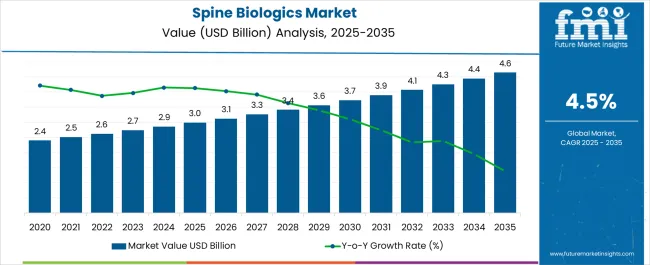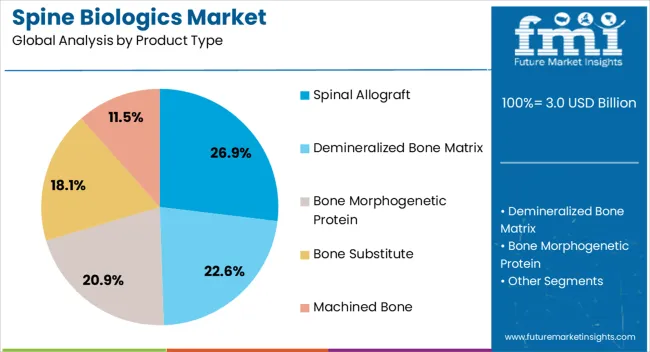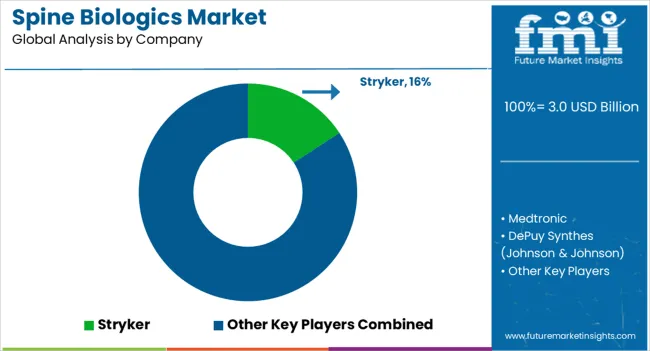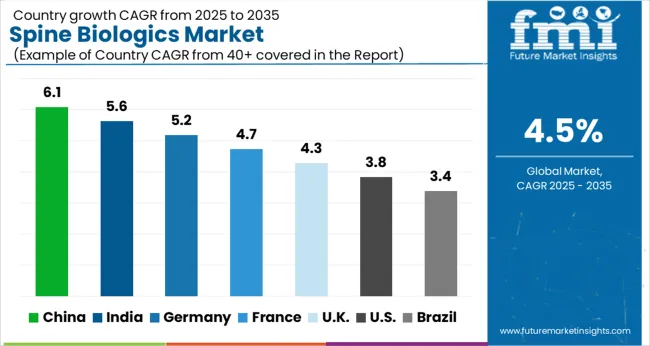The Spine Biologics Market is estimated to be valued at USD 3.0 billion in 2025 and is projected to reach USD 4.6 billion by 2035, registering a compound annual growth rate (CAGR) of 4.5% over the forecast period.

| Metric | Value |
|---|---|
| Spine Biologics Market Estimated Value in (2025 E) | USD 3.0 billion |
| Spine Biologics Market Forecast Value in (2035 F) | USD 4.6 billion |
| Forecast CAGR (2025 to 2035) | 4.5% |
The spine biologics market is experiencing consistent growth, driven by the rising prevalence of spinal disorders and the increasing number of spinal fusion procedures worldwide. The demand for advanced biologic solutions is being reinforced by the growing aging population, which is more prone to degenerative spine diseases, as well as the rising incidence of trauma and lifestyle-related spinal injuries.
Advancements in regenerative medicine and biologic technologies are enabling improved patient outcomes, reduced recovery times, and enhanced surgical success rates, which are further supporting adoption. Increasing preference for minimally invasive spine surgeries is also fueling the use of biologics, as these products contribute to faster healing and lower complication risks.
Strong focus from healthcare providers on solutions that can improve bone healing and fusion success is creating favorable conditions for sustained growth With continuous research in cell-based therapies and synthetic alternatives, along with supportive reimbursement structures in several regions, the market is positioned to expand significantly in the coming years as both patients and surgeons embrace biologics as essential components of spinal treatment strategies.
The spine biologics market is segmented by product type, and geographic regions. By product type, spine biologics market is divided into Spinal Allograft, Demineralized Bone Matrix, Bone Morphogenetic Protein, Bone Substitute, and Machined Bone. Regionally, the spine biologics industry is classified into North America, Latin America, Western Europe, Eastern Europe, Balkan & Baltic Countries, Russia & Belarus, Central Asia, East Asia, South Asia & Pacific, and the Middle East & Africa.

The spinal allograft segment is projected to account for 26.9% of the spine biologics market revenue share in 2025, making it the leading product type. Its prominence is being supported by the reliable osteoconductive properties that promote natural bone growth and fusion in spinal surgeries. The widespread availability of allograft materials through established tissue banks ensures consistent supply, which has made them a preferred choice among surgeons.
Reduced surgical time and the elimination of donor site morbidity compared to autografts are key advantages driving their adoption. The segment is also benefiting from the rising number of spinal fusion procedures globally, as allografts provide structural support and facilitate faster integration with host bone.
Continuous advancements in sterilization, preservation, and processing techniques are improving the safety and effectiveness of these grafts, further reinforcing surgeon confidence With the increasing demand for biologics that can support minimally invasive procedures and deliver predictable outcomes, spinal allografts are expected to maintain their leadership within the product type segment of the spine biologics market.
The demand for spine biologics is likely to rise due to the number of spine cord injuries, bone fusion surgery, and degenerative disk globally during the forecast period. Additionally, the growing generic population and rising advanced bone grafting will accelerate the spine biologics market in recent years. Further, the rising adoption of spine biologics treatment with growing awareness among patients will boost the spine biologics market size during the foreseen time.
The key market manufacturers are developing the best quality metallic plates and rods for the patient's treatment which are adopted by healthcare surgeons. This is likely to advance the spine biologics market growth during the forecast period. However, these metallic materials are used widely in the healthcare sector because the fast bone healing process among patients is likely to increase the adoption of spine biologics during the forecast period.
It is an ideal approach by key healthcare manufacturers, which is safe, reduces injury, and aids recovery faster. These factors will propel the market size of global spine biologics. Moreover, spine disorders or spine implants by the aged population are mushrooming the market growth in recent years. Based on product type, the market is further categorized into spinal allograft, demineralized bone matrix, bone morphogenetic protein, bone substitute, and machined bone.
The spinal allograft dominates the market for global spine biologics by securing a significant share and healthy growth during the forecast period. A spinal allograft is a bone that is likely to be donated from one person to another for spine treatment. It eliminates the surgery time during the procedures and is likely to increase the demand for spinal allografts during the forecast period.
Moreover, prominent companies are focusing on this treatment and advancing to promote spinal allograft procedures. Several international companies are likely to increase the demand for natural bone grafts and related products and are likely to flourish the market growth in recent years.
Based on region, North America dominates the spine biologics market by securing the highest share during the forecast period. Due to growing numbers of rheumatoid arthritis and improves the healthcare sector during the foreseen time. Moreover, rapid urbanization, rising per capita income, and developing new technologies are accelerating the adoption of spine biologics in the region.
On the other hand, key players play a crucial role in the market by focusing on the patient's requirements. They are capturing the lion's share in the market by adopting several marketing methodologies. Some of them are mergers, collaborations, acquisitions, partnerships, and product launches, among others.
A biologic material is a substance that actively alters the surrounding environment and effects a change in the environment that progresses through an active biological process, the effects can be seen through increased cellular activity, growth, and differentiation. A biologic material or bone graft attracts more cells to the fusion site can actively increase bone formation and stimulate spinal fusion.
Spine Biologics constitute of material that can be used in bone fusion surgery, spinal cord injury and degenerative disc disease. The use of biologics in spine surgery has always been an important component in any spinal fusion surgery. The biologic material or bone graft is a critical element in the fusion healing process. In the past, there were few options, primarily using the patient's own bone (ie, autograft).
The surgeon removed bone from one area of the patient's body (eg, iliac crest/hip) and used the bone as graft implanted into the spine for fusion. Many surgeons still use autograft as their primary bone graft of choice. However, the use of autograft often requires a separate surgical incision and removal of bone from an area of the body outside the spine, furthermore, availability of autograft is limited.
Typically, bone can only be removed from an area once. This can present a problem for patients who require additional surgery. In children, the areas available for autograft are small, and there may not be enough bone to successfully heal the fusion. These scenarios represents some of the reasons why other types of biologic materials are needed. The ultimate goal of fusion is to restore disc height, alignment, and stability. In order for new bone to form, three critical elements are required:
Spine Biologics market is growing due to advancement in technology, demand for better minimally surgical procedures that support doctor and reduce in hospitalization timing. Also rise in prevalence of diseases due to aging population and related disease like rheumatoid and osteoarthritis, obesity, government funding, increased awareness and requirement for reduced hospital stay is driving the market in most regions.
Spine Biologics has a tremendous demand in Americas region and pool the largest share in Spine Biologics market also due to increase in awareness Asia-Pacific region will show tremendous growth in future with highest population countries in Asia will drive it tremendously adding to the market share. The biggest restrain in the market is the healthcare cost for such procedures and the substitute product available.
Spine Biologics is gaining popularity as it is minimally invasive and require lesser time of stay at hospital than open surgical procedures. The market is experiencing increase owing to increased awareness and sophisticated diagnostic technique, also markets have been witnessing considerably high growth because of increase in patient pool and procedure numbers of osteoarthritis and rheumatoid arthritis.
Spine Biologics market is experiencing growth in the developed countries because of high prevalence, improving healthcare facility, economic growth, insurance coverage and fast disease progression. North America constitutes the largest share in the global market, followed by Europe.
The North American spine biologics market is experiencing significant growth in the region as a result of the growing population, awareness of newly developed technologies, increased per capita income of the hospitals and the people, improved medical literacy.

Some of the key market players in global Spine Biologics Market are Alphatech Spine, Medtronics, Biomet, Globus medical, Exactech, RTI Biologics, Zimmer, Small Bone Innovations, Stryker, Amedica, K2M, NuVasive, Precision Spine, TranS1 to name a few.
The research report presents a comprehensive assessment of the market and contains thoughtful insights, facts, historical data, and statistically supported and industry-validated market data. It also contains projections using a suitable set of assumptions and methodologies. The research report provides analysis and information according to categories such as market segments, geographies, types, technology and applications.
The report is a compilation of first-hand information, qualitative and quantitative assessment by industry analysts, inputs from industry experts and industry participants across the value chain. The report provides in-depth analysis of parent market trends, macro-economic indicators and governing factors along with market attractiveness as per segments. The report also maps the qualitative impact of various market factors on market segments and geographies.

| Country | CAGR |
|---|---|
| China | 6.1% |
| India | 5.6% |
| Germany | 5.2% |
| France | 4.7% |
| UK | 4.3% |
| USA | 3.8% |
| Brazil | 3.4% |
The Spine Biologics Market is expected to register a CAGR of 4.5% during the forecast period, exhibiting varied country level momentum. China leads with the highest CAGR of 6.1%, followed by India at 5.6%. Developed markets such as Germany, France, and the UK continue to expand steadily, while the USA is likely to grow at consistent rates. Brazil posts the lowest CAGR at 3.4%, yet still underscores a broadly positive trajectory for the global Spine Biologics Market. In 2024, Germany held a dominant revenue in the Western Europe market and is expected to grow with a CAGR of 5.2%. The USA Spine Biologics Market is estimated to be valued at USD 1.1 billion in 2025 and is anticipated to reach a valuation of USD 1.6 billion by 2035. Sales are projected to rise at a CAGR of 3.8% over the forecast period between 2025 and 2035. While Japan and South Korea markets are estimated to be valued at USD 158.0 million and USD 86.9 million respectively in 2025.
| Item | Value |
|---|---|
| Quantitative Units | USD 3.0 Billion |
| Product Type | Spinal Allograft, Demineralized Bone Matrix, Bone Morphogenetic Protein, Bone Substitute, and Machined Bone |
| Regions Covered | North America, Europe, Asia-Pacific, Latin America, Middle East & Africa |
| Country Covered | United States, Canada, Germany, France, United Kingdom, China, Japan, India, Brazil, South Africa |
| Key Companies Profiled | Stryker, Medtronic, DePuy Synthes (Johnson & Johnson), Zimmer Biomet, NuVasive, Inc., Orthofix., Arthrex, Inc., Exactech, Inc., Organogenesis Inc., and Kuros Biosciences. |
The global spine biologics market is estimated to be valued at USD 3.0 billion in 2025.
The market size for the spine biologics market is projected to reach USD 4.6 billion by 2035.
The spine biologics market is expected to grow at a 4.5% CAGR between 2025 and 2035.
The key product types in spine biologics market are spinal allograft, demineralized bone matrix, bone morphogenetic protein, bone substitute and machined bone.
In terms of , segment to command 0.0% share in the spine biologics market in 2025.






Full Research Suite comprises of:
Market outlook & trends analysis
Interviews & case studies
Strategic recommendations
Vendor profiles & capabilities analysis
5-year forecasts
8 regions and 60+ country-level data splits
Market segment data splits
12 months of continuous data updates
DELIVERED AS:
PDF EXCEL ONLINE
Spine Pain Market Size and Share Forecast Outlook 2025 to 2035
Spine Positioning Devices Market
Cervical Spine System Market – Innovations, Trends & Forecast 2025 to 2035
United States Spine Pain Market Trend Analysis Based on Product, Pain, End-User, and Regions 2025 to 2035
Non-Operative Spine Care Market
Minimally Invasive Spine Technologies Market Size and Share Forecast Outlook 2025 to 2035
Biologics Contract Manufacturing Market Size and Share Forecast Outlook 2025 to 2035
Biologics Market Analysis - Growth & Forecast 2025 to 2035
Competitive Overview of Biologics Regulatory Affairs Market Share
Middle East & Africa (MEA) Biologics and Biosimilar Market Analysis by Drug, Drug Class, Dosage Form, Indication, Distribution Channel, and Country through 2035
Orthobiologics Market is segmented by Product Type and End User from 2025 to 2035
Retinal Biologics Market Size and Share Forecast Outlook 2025 to 2035
Inhalable Biologics Market Analysis - Size, Share, & Forecast Outlook 2025 to 2035
Veterinary Biologics Market - Size, Share, and Forecast 2025-2035
Global Respiratory Biologics Market Analysis – Size, Share & Forecast 2024-2034
Subcutaneous Biologics Market
Biosimilar and Biologics Market Analysis – Size, Share, and Forecast Outlook 2025 to 2035
Breaking Down Market Share in Anti-Inflammatory Biologics
Global Self-administered Biologics Market Analysis – Size, Share & Forecast 2024-2034
Retinal Drugs And Biologics Market

Thank you!
You will receive an email from our Business Development Manager. Please be sure to check your SPAM/JUNK folder too.
Chat With
MaRIA